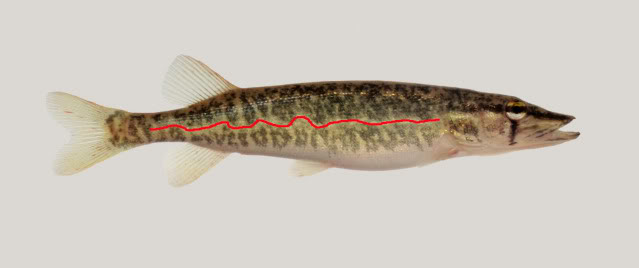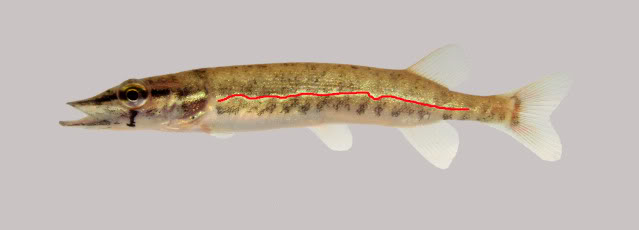Grass Pickerel - BIO 210 Species Study
Reproduction
The principal form of reproduction in
Esox americanus vermiculatus is a form of external
fertilization known as spawning. Spawning is a common method for
reproduction in fish, but spawning periods vary with each
particular species of fish. It is typical of E. americanus
vermiculatus to congregate for spawning at the earliest
signs of spring, particularly immediately after ice recedes on
freshwater lakes. (COSEWIC, 2005) During this
congregation period for spawning, the differentiation between
female and male E. americanus vermiculatus is evident due
to the enlarged female stomach that can be observed previous to
spawning. (Kleinert and Mraz, 1966) Spawning begins with the
female depositing her eggs into the open water which either fall
to the water bottom or become attached to other aquatic
vegetation. Typically E. americanus vermiculatus eggs
attach to aquatic vegetation during spawning due to the densely
vegetated habitat they are attracted to. (Fisheries and Oceans
Canada, 2012) Following the depositing of eggs, males follow
behind and deposit spermatozoa over the unfertilized female eggs
to begin fertilization.
For roughly two weeks, both male and female E.
americanus vermiculatus repeat this process of spawning for the
spring. (Kleinert and Mraz, 1966) It is important to note that during
spawning of this particular species of fish, both sexes are equally
represented. (Kleinert and Mraz, 1966) This characteristic deviates from
a variety of fish species in which the male sex is overrepresented, and
many males follow behind one female in hopes of fertilizing her eggs.
Differentiation between freshly fertilized eggs and
mature fertilized eggs in E. americanus vermiculatus is evident
in the color and transparency of the eggs. Shortly after fertilization,
eggs generally appear opaque and white in contrast to mature, fertilized
eggs which appear transparent and off-yellow in color. (Kleinert and
Mraz, 1966) In other words, transparency versus opaqueness can be a
great indicator of sexual maturity of the egg.
E. americanus vermiculatus typically spawn
in large quantity, meaning many fish of this species congregate together
to spawn rather than spawn individually or in smaller packs. (Kleinert
and Mraz, 1966) It is atypical to find individual spawning “beds” among
this species due to its specificity of habitat as well as for reasons of
reproductive success. The few fish of this species that deviate from
spawning in large quantities still spawn in their preferred habitats.
(Fisheries and Oceans Canada, 2012) It should also be noted that females
deposit large quantities of eggs during spawning for fertilization. (Kleinert
and Mraz, 1966)
Roughly a ten day period must pass before the
mature eggs hatch into free-swimming organisms. (Kleinert and Mraz,
1966)
In addition to the known spring spawning period, it
has been recorded that smaller spawning periods may occur in the fall. (Kleinert
and Mraz, 1966)

